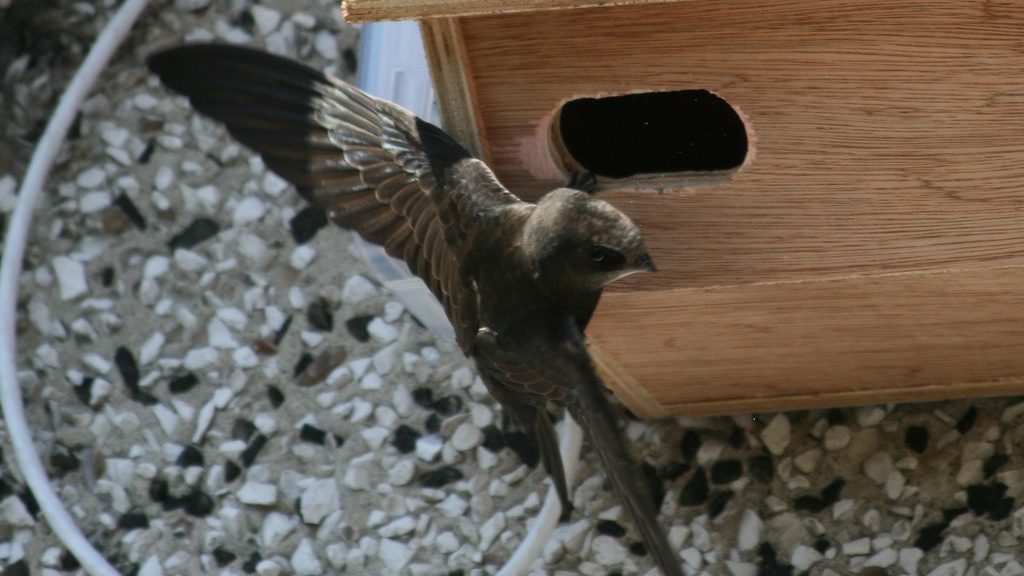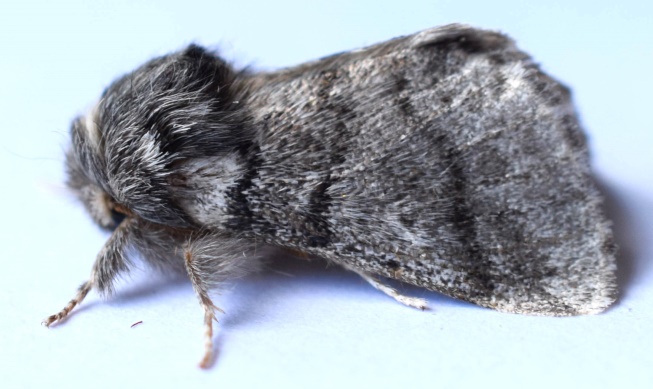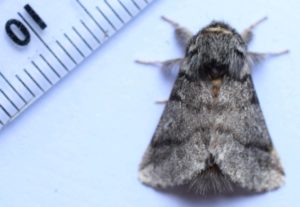The METRO explain how to make it easy for yourself to live more sustainably in 2022 by introducing changes that require initial action and then become low-maintenance habits.
Category Archives: Feature
Saving Swifts – the Normandy swift project
At one time swifts were a common sight in our summer skies, performing their aerial acrobatics, wheeling and screaming their high-pitched calls after their marathon journeys from Africa. Sadly, these sights and sounds are less common nowadays since the number of these iconic birds arriving on our shores is unfortunately declining.
One reason for their decline is the limited availability of suitable UK nesting places. Swift conservation organisations (swift-conservation.org) are ‘doing their bit’ to counteract the problem. Could Normandy help? FNW believed that it could!
In 2018, the Head of the ‘Swift Conservation organisation’, Edward Mayer, had given a talk to FNW members in which he explained that Normandy should provide a good environment for swifts, and he recommended the Village Hall as an ideal building on which to site some nest boxes. We learnt that the nearby bird reserve at Tices’ Meadow had erected a swift nesting tower. Could Normandy do something similar? FNW decided to take up the challenge; we would set out to attract swifts into the local area by providing, not a tower, but nest boxes on the Village Hall.
Getting the project of the ground….
FNW committee members discussed the idea with members of the Management Committee of Normandy Village Hall who were very supportive and helpful. We all agreed to place four swift nest boxes unobtrusively under the eaves of the Village Hall. The site selected was on the end of the building nearest to the car park. We had to make sure there were no means of access for rats or squirrels; that the entrances were sheltered from wind and rain; and that the boxes were clear of obstructions to allow the birds to fly straight into the entrance holes. Swifts are tidy birds and the adults eat their chicks’ droppings so the set-up would be as maintenance free as possible.
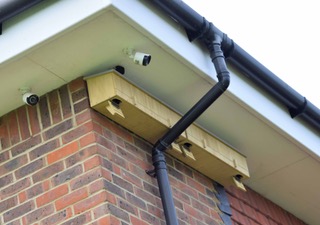
Enticing the birds to their new homes….
Having bought some suitable nest boxes we had to think about how to attract some occupants. We knew swifts had been seen flying around the area but we needed to attract them to these new ‘Des Reses’. A recommended way of doing this is to play them swift calls, so we also mounted a small specialised ‘swift call’ mp3 player near the nest boxes.
Breeding birds arrive from Africa in early May returning to the nest sites they had used in previous years, hopefully in the local Normandy area. Two-year-old birds return to the UK from mid-May onwards looking for a nest site, and to mate and start nest building, although they will not actually breed until the following year. It is these birds that we hope to attract. One-year old birds arrive in July and do not stay long, but they are looking for swift colonies to join so we could attract these as well. With these dates in mind, calls are played from mid-May and continuing until the third week in July.
Let’s all keep our fingers crossed and hope for success!
It could take several years to entice the swifts to nest – this is year 2 of the project – but we know swifts have been spotted in the parish so we can hope that it is a lot sooner. House sparrows might build in the nest boxes to begin with, but these little birds are also declining so that would be good! We would just need to clean the boxes out afterwards.
From May onwards keep looking skywards and if you see swifts in the area please let us know. If you see them exploring the nest boxes then that would be even better!
Top photo of swift at box by fs-phil under creative commons.
Box-tree moth, Agapanthus gall midge and Gypsy moth arrive in Normandy – Gardeners Beware!
Species that have been introduced into areas outside their natural range through human actions and that pose a threat to native wildlife, are known as invasive non-native species. Sadly some have made their way to Normandy, affecting our native wildlife. However, you can help, by recognising them and reporting them, and even taking measures to control them. Read these details, from FNW Committee member, Bill Stanworth, on three such species to look out for.
The box-tree moth (Cydalima perspectalis) has been recorded for the first time in Normandy at Springhill garden. Adult moths were attracted to a mercury vapour lamp in July 2020 and later in the year larvae were found on its foodplant, box (Buxus sempervirens) growing in the same garden. The moth is a native of the Far East and so its arrival in Europe (in 2006) is thought to have been from imported box plants – ugh.
The first record of the moth in the U.K. was from Kent in 2007 but a year later it was found in Weybridge, Surrey. Since then the moth has been gradually increasing and from distribution maps the moth may have been in our area for a year or so. Papers about the moth and its distribution can be found on the RHS website.
The adult moth, shown below is large and very distinctive. Its markings are variable and even a brown form exists. The stripy green caterpillar is also quite distinctive and is shown resting below on its foodplant. It creates silk strands that tie leaves together forming a lair from which it can feed and retreat into, in times of danger.
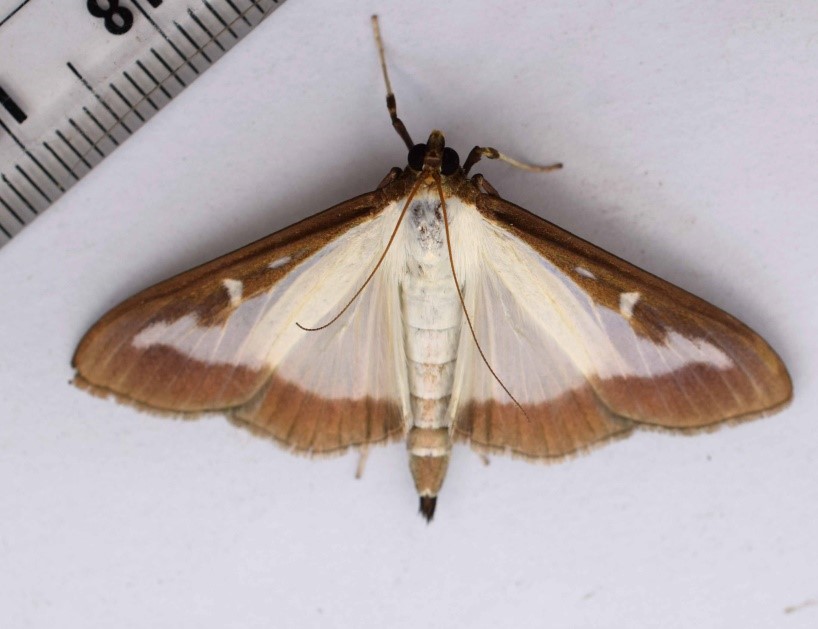
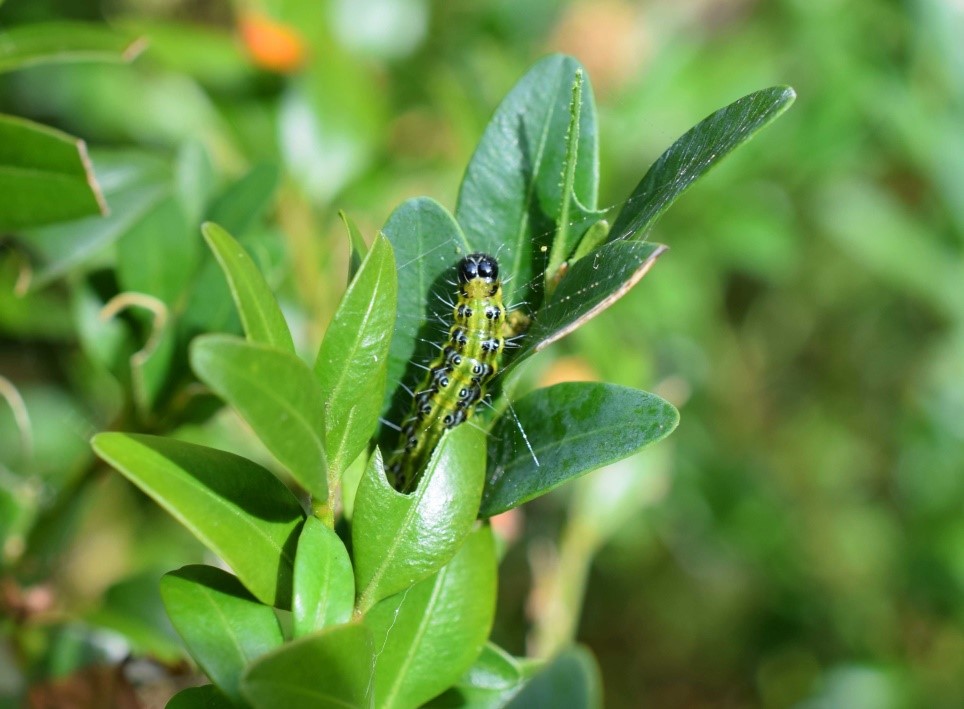
You can see from the photos below that even in less than one season they can seriously damage the plant. Feeding signs and frass are shown on the left and serious defoliation on the right. If you see this happening to your box bushes please check with the RHS and other websites for control methods (preferably using the non-pesticide methods).
We urge you to control this species as box is a native plant in southern England and it could have a serious effect on our best-known native boxwood at Box Hill, Surrey and other sites in the county and country. If you see the box-tree moth the RHS would like to know, you can submit your records on their website via their box-tree moth survey.
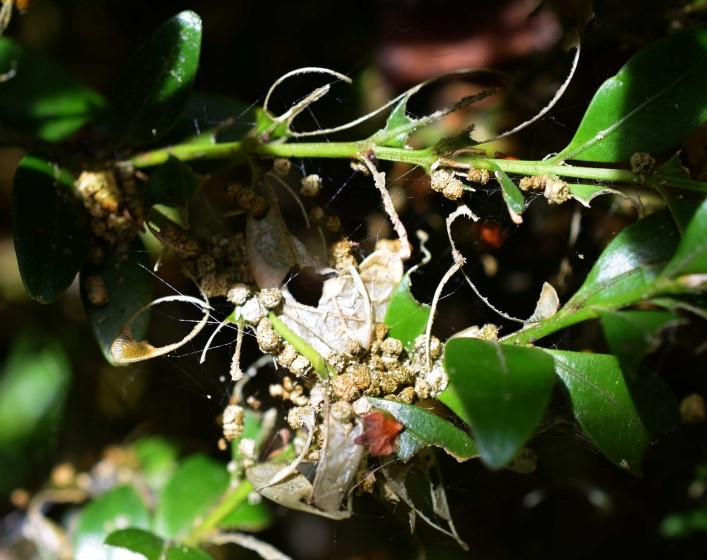

The second pest to look out for is the Agapanthus gall midge, which was also found in Springhill garden for the first time in 2020. It’s another devastating pest (if you grow Agapanthus in your garden!), a fly this time, that lays its eggs on the young Agapanthus flower buds. The tiny, creamy-yellow larvae develop and cause the flower bud to become distorted, go brownish and most fail to open. A photograph of the affected buds (here detached from the plants) is shown below.
According to the RHS the midge causing this was new to science and only discovered in 2014, this time at Wisley but it is probably a native of southern Africa, home of the plants. Control methods are given on the RHS website. Agapanthus flowers are popular with some native pollinators; an example shown here is probably a melanistic garden bumblebee (Bombus hortorum) from Springhill garden. This one spent a lot of time on this white flowered variety! Sadly many Agapanthus flowers at Springhill were ruined this year.
The RHS are asking for help from gardeners who have seen agapanthus gall midge or damaged flowers and request you send photos of symptoms on the flowers and buds, plus opened buds showing larvae where possible, to entomology@rhs.org.uk on their website.
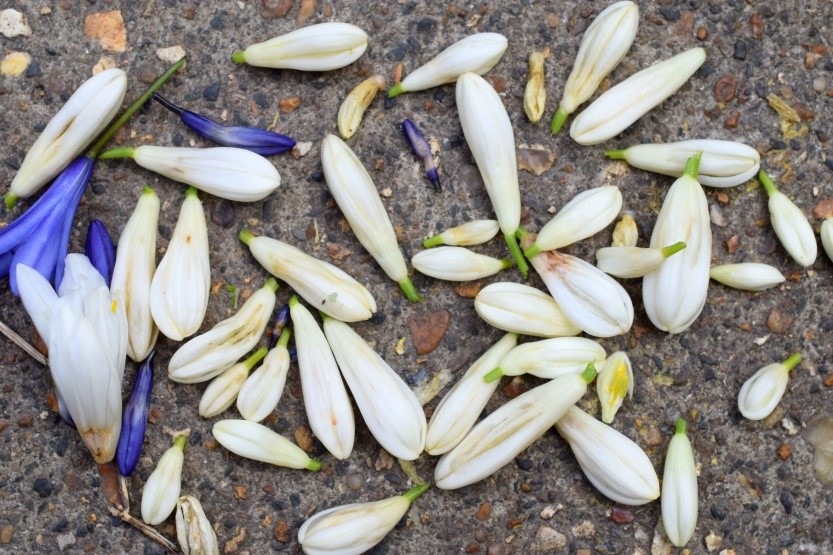
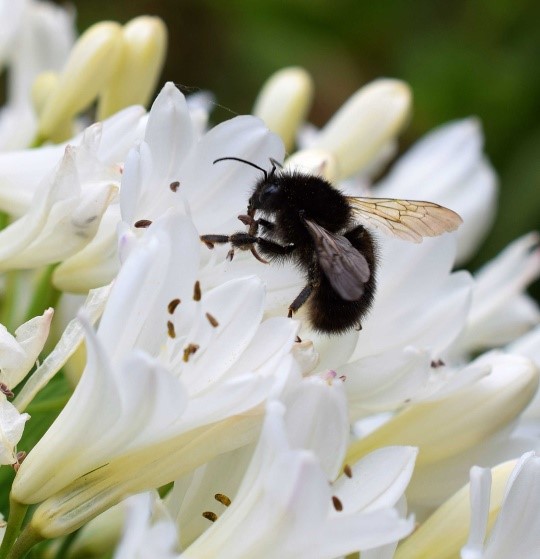
Another invader and potential pest is the gypsy moth (Lymantria dispar). The male shown below was attracted to a mercury vapour lamp at Springhill garden on 7 August 2020. On mainland Europe the moth can be a serious pest, stripping broadleaved trees (particularly apple, plum and willows; oaks and poplars in forests) and bushes.
Look out for patches of eggs covered with yellow/brown hairs on trunks and walls over winter or for large dark grey/black hairy caterpillers with reddish spots from April to June/July. Apparently the hairs don’t cause irritation of the skin unlike the oak processionary moth. The RHS website says ‘whilst a single defoliation from this caterpillar even early in the season, should not affect the vigour of a host plant, repeated defoliations can have an adverse effect’ and advice is given with regards control. They also very sensibly say ‘where possible tolerate populations of caterpillars’.
This moth (not mentioned/recorded in ‘The Larger Moths of Surrey’ [Graham A. Collins] published by SWT in 1997) was a former resident in the East Anglian fens but it lived on bog-myrtle and creeping willow and so wasn’t considered a pest. The European strain was accidentally introduced and has spread rapidly in the London area. Hopefully, as the large bodied females are mostly flightless, we won’t be troubled for a while.
There is no statutory requirement to notify sightings of gypsy moth to the plant health authorities but you can report serious damage to the government’s ‘Forest Research’ website: TreeAlert (their on-line pest reporting tool).
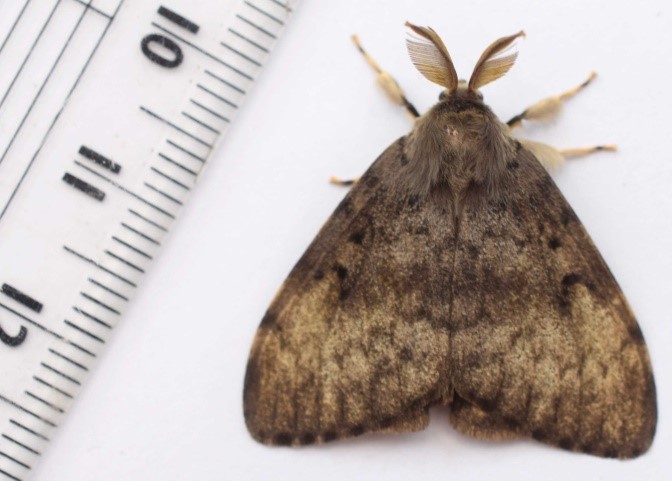
2018 saw the first arrival of the oak processionary moth (Thaumetopoea processionea) to Normandy (see our previous article). No moths were seen in Normandy in 2019 as far as we know but you may have seen that the Forestry Commission have erected posters warning the public to be alert for them and report them when seen. In addition at least one team has been seen on Normandy Common searching for evidence of their presence. This year three males were attracted to the mercury vapour lamp at Springhill so please stay vigilant.
Wishing you a merry sustainable Christmas!
Christmas is not always the most environmentally friendly time of the year, while it is the most wonderful! From the tree to the wrapping paper, the food to the Christmas crackers, the gifts to the Christmas cards, the choices we make will have a massive impact on our planet. Read more on this here and please share in the comments section below your ideas for how you make Christmas more sustainable and environmentally-friendly.

As you prepare for Christmas this year you may want to stop and think about our natural world as you plan the gifts you give to your loved ones. We all want to show those closest to us that we care, but even better if we show at the same time how we care for the planet on whose health we all depend.
Do they really want that present, or will they use it once and throw it away? You don’t want to inadvertently waste the resources used to manufacture a gift which sits in a cupboard unused or is thrown in the bin contributing to unnecessary waste.
Think about the carbon footprint of your gifts – that special present from abroad will likely have flown more than you will have this year.
Have a conversation with your friends and family about how to make this Christmas a more sustainable holiday. Make sure they know that you would prefer not to receive those joke gifts you laugh at once and throw away, or that you would prefer a donation is given to charity as you have everything you want.
A search on the internet for sustainable gifts will provide a wealth of choices, and here are just a few ideas (please note, we are not recommending, endorsing or promoting these online stores, but sharing them to give you a flavour of what is available).
Protect the Planet – Eco-friendly gifts for everyone – no matter what your budget. https://www.protecttheplanet.co.uk/eco-friendly-gifts
Adopt an animal – Think about adopting a tiger, elephant or dolphin or sponsoring a rescue dog or cat for your loved one, which usually provides photos and updates on the animal(s) that are receiving help at the same time. Many charities offer this including WWF, RSPCA, Wildlife Trusts, Wildfowl and Wetlands Trust, and lots more.

Natural Collection – Natural Collection offer a curated range of hand-crafted home ware, ethically sourced fashion and natural beauty essentials to complement your eco-conscious lifestyle. We do our best to promote healthy and sustainable living in every aspect, offering organically sourced household essentials, earth friendly cleaning alternatives and artisan made foods. https://www.naturalcollection.com/?utm_source=AFW&utm_medium=affiliate&utm_campaign=AFW&awc=3650_1604921558_1dc14b2785e818a9e13c238a3a7c9392
WEARTH London – Give thoughtful sustainable gifts whilst supporting independent UK brands with our range of ethically sourced and environmentally conscious presents. You can also discover all of our zero waste gifts by using our plastic-free filter. All deliveries are carbon neutral. https://www.wearthlondon.com/all-ethical-gifts?sort=sort_order_asc&page=1
WWF Green Christmas Gift Guide – From Christmas cards to reusable cups, we’ve got you covered this season with sustainable gifts that can help in the #FightForYourWorld. https://www.wwf.org.uk/green-christmas-gift-guide
Please do share your ideas for a greener Christmas in the comments below. We wish all of our members and readers a joyous Christmas!
Top photo by Tracy under creative commons of wrapping paper sheets made from old book and magazine pages sewn together by machine & finished off with ribbons of old VHS tape. Second photo by waferboard under creative commons.
Protected: Normandy Species Distribution Maps – Members Only
PEST! Oak Processionary moth (OPM) has arrived in Normandy
This moth was trapped in a Normandy garden in early August this year. It has been reported to the Forestry Commission who says that their nests have been found in the Pirbright area. OPM are a pest species in Europe and also a health hazard. Additional information on the moth is given below. If you find caterpillers or nests please don’t disturb them but report to the Forestry Commission as directed below, to the land owner (see below) and or to us.
Selected OPM information from the Forestry Commission’s website:
OPM (Oak Processionary Moth) was accidentally introduced from continental Europe into London in 2005 and, despite eradication attempts, it has become established and the area affected has grown. (Normandy is currently outside the 2018 Core zone for OPM and in the Control or buffer zone.) Nevertheless, OPM cannot be left uncontrolled, and the main focus of control now is to prevent or limit further outward spread of the pest. This requires action by everyone who owns or manages oak trees in the affected areas.
Contact with the hairs can cause itching skin rashes and, less commonly, sore throats, breathing difficulties and eye problems. This can happen if people or animals touch caterpillars or their nests, or if the hairs are blown into contact by the wind. The greatest risk period is May to July, but they can be present on old nests, and could be blown or touched at any time of year. Detection of adult males, which are strong flyers and can travel several kilometres from the nest from which they emerged, does not necessarily mean that the infestation has spread and a new breeding population is being established. By contrast, the female is not a strong flyer, and is rarely found more than about 500 metres from her original nest. However, carrying out visual surveys for egg masses over the following winter, and for larvae the next spring, is recommended in areas where males are trapped. All oak trees within 200 metres of where OPM is trapped should be inspected as soon as possible in case there are nests present. A second inspection later in the year is also considered wise.
Oak Processionary Moth (Thaumetopoea processionea) caterpillars are covered with thousands of minute, irritating hairs which can be released as a defence mechanism or blown off by the wind. The larvae develop tiny, irritating hairs from their third (L3) stage onwards to pupation. A single, fully grown larva can carry thousands of hairs. These hairs, which are barbed, contain an irritating substance called thaumetopoein, from which the species gets part of its scientific name, Thaumetopoea processionea.
The caterpillars build communal nests on the trunks and branches of oak trees to protect themselves from predators. Once released, the hairs can persist in the nests and the environment for a long time, posing a long-term nuisance to people and animals, such as horses and dogs, unfortunate enough to come into contact with them.
Advice on Guildford Borough Council’s website:
What to do if you see OPM
If you see any OPM nests or caterpillars, do not touch or approach them. The caterpillars have a distinctive habit of moving about in or under oak trees in nose-to-tail processions, which gives them their name.
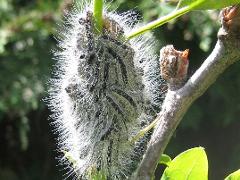 The silken webbing nests are white when new, and often have silken trails leading to them. They quickly become discoloured and harder to see against the dark colour of oak tree bark.
The silken webbing nests are white when new, and often have silken trails leading to them. They quickly become discoloured and harder to see against the dark colour of oak tree bark.
The main risk period is April to July, when the caterpillars are active. However, avoid nests, even ‘spent’ nests, at any time, because the hairs in them can remain irritating for many months. Nests can sometimes fall to the ground.
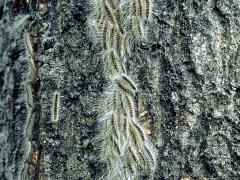 Report them immediately to the Forestry Commission, which is leading efforts to control its population, spread and impacts.
Report them immediately to the Forestry Commission, which is leading efforts to control its population, spread and impacts.
How to report OPM
Please report sightings on Guildford Borough Council owned land to Parks & Leisure Services by emailing parks@guildford.gov.uk or phoning 01483 444 718.
Please report sightings on other land in the borough to the Forestry Commission using their Tree Alert online pest reporting form, which you can access at the Forestry Commission website. You will have to add a photograph to your report, but do not risk contact to get a photograph.
It would be courteous to contact the landowner if you know who they are.
If you cannot use Tree Alert or get a photograph, you may report them by email to opm@forestry.gsi.gov.uk or by phoning 0300 067 4442.

